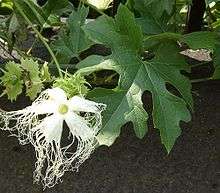Trichosanthes kirilowii
Trichosanthes kirilowii is a flowering plant in the family Cucurbitaceae found particularly in Henan, Shandong, Hebei, Shanxi, and Shaanxi. It is one of the 50 fundamental herbs used in traditional Chinese medicine, where it shares the name guālóu (Chinese: 栝蔞) with the related T. rosthornii. It is known as "Chinese cucumber" and "Chinese snake gourd" in English.[note 1]
| Trichosanthes kirilowii | |
|---|---|
 | |
| Scientific classification | |
| Kingdom: | Plantae |
| Clade: | Tracheophytes |
| Clade: | Angiosperms |
| Clade: | Eudicots |
| Clade: | Rosids |
| Order: | Cucurbitales |
| Family: | Cucurbitaceae |
| Genus: | Trichosanthes |
| Species: | T. kirilowii |
| Binomial name | |
| Trichosanthes kirilowii | |
| Synonyms | |
|
Trichosanthes japonica Regel | |
Traditional uses
The tuber of this plant is known in Mandarin as tiān huā fěn (Chinese: 天花粉). In traditional Chinese medicine it is said to drain heat and generate fluids, clear and drain lung heat, transform phlegm, and moisten lung dryness, and resolve toxicity and expel pus.[3] The fruit of the plant, also referred to in Mandarin as guālóu (Chinese: 瓜蔞), is said to clear heat and transform phlegm-heat, unbind the chest, reduces abscesses and dissipate nodules.[4] Both forms should be considered safe only for use with professional guidance by someone trained in their use, though this may be an unnecessary extrapolation from the toxicity of purified trichosanthin. Extracts from the plant have been shown to damage the protein coat on the RNA of the AIDS virus in vitro.[5]
Chemical components
The plant is a source of the ricin-like protein trichosanthin.[1][6]
Notes
- Robinson and Decker-Walters (1997[2]) p. 203-206: "Chinese snake gourd" preferred name for Trichosanthes kirilowii, and Trichosanthes kirilowii preferred definition for "chinese snake gourd".
References
- "Trichosanthes kirilowii". Germplasm Resources Information Network (GRIN). Agricultural Research Service (ARS), United States Department of Agriculture (USDA). Retrieved 2012-02-26.
- Robinson RW and DS Decker-Walters. 1997. Appendix: Common Cucurbit Names and their Scientific Equivalents. in: Cucurbits. CAB International, USA.
- Bensky, D; Clavey S; Stöger E; Gamble A (2004). Chinese Herbal Medicine Materia Medica. Seattle: Eastland Press. pp. 108–111. ISBN 0-939616-42-4.
- Bensky, D; Clavey S; Stöger E; Gamble A (2004). Chinese Herbal Medicine Materia Medica. Seattle: Eastland Press. pp. 383–386. ISBN 0-939616-42-4.
- Sui S, Zhao W; Feng D; Sun S; Han T (Feb 2010). "Acta Biochimica et Biophysica Sinica". 42 (2). Shanghai: Acta Biochimica et Biophysica Sinica: 91–7. Cite journal requires
|journal=(help) - Ferrari, P.; Trabaud, M. A.; Rommain, M.; Mandine, E.; Zalisz, R.; Desgranges, C.; Smets, P. (1991). "Toxicity and Activity of Purified Trichosanthin". AIDS. 5 (7): 865–870. doi:10.1097/00002030-199107000-00011. PMID 1892592.
External links
- "Trichosanthes kirilowii List of Chemicals". Dr. Duke's Databases. United States National Agricultural Library.